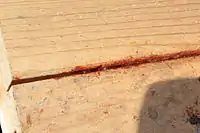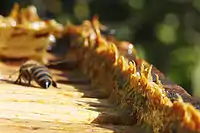Propolis
Propolis or bee glue is a resinous mixture that honey bees produce by mixing saliva and beeswax with exudate gathered from tree buds, sap flows, or other botanical sources. It is used as a sealant for unwanted open spaces in the hive. Propolis is used for small gaps (approximately 6 millimeters (1⁄4 in) or less), while larger spaces are usually filled with beeswax. Its color varies depending on its botanical source, with dark brown as the most common. Propolis is sticky at and above 20 °C (68 °F), while at lower temperatures it becomes hard and brittle.


When foraging, worker bees primarily harvest pollen and nectar, while also collecting water and plant resin necessary for the production of propolis.[1] The chemical composition and nature of propolis depend on environmental conditions and harvested resources.[2]
Purpose
For centuries, beekeepers assumed that bees sealed the beehive with propolis to protect the colony from the elements, such as rain and cold winter drafts.[3] However, 20th-century research revealed that bees not only survive, but also thrive, with increased ventilation during the winter months throughout most temperate regions of the world.
Propolis functions may include:[4]
- Reinforce the structural stability and reduce vibration
- Provide improved thermal insulation to the hive and reduce water loss
- Provides protection from pathogens, via anti-fungal and antibacterial properties[5][6]
- Make the hive more defensible against parasites and predators by narrowing the existing entrance (in wild colonies) to a single "choke point"
- Mitigate putrefaction within the hive. Bees usually carry waste out of and away from the hive. However, if a small lizard or mouse, for example, finds its way into the hive and dies there, bees may be unable to carry it out through the hive entrance. In that case, they would attempt instead to seal the carcass in propolis, essentially mummifying it and making it odorless and harmless.
Composition

The composition of propolis varies from hive to hive, from district to district, and from season to season.[7] Normally, it is dark brown in color, but it can be found in green, red, black, and white hues, depending on the sources of resin found in the particular hive area. Honey bees are opportunists, gathering what they need from available sources, and detailed analyses show that the chemical composition of propolis varies considerably from region to region, along with the vegetation. In northern temperate climates, for example, bees collect resins from trees, such as poplars and conifers (the biological role of resin in trees is to seal wounds and defend against bacteria, fungi, and insects). "Typical" northern temperate propolis has approximately 50 constituents, primarily resins and vegetable balsams (50%), waxes (30%), essential oils (10%), and pollen (5%). Propolis also contains persistent lipophilic acaricides, a natural pesticide that deters mite infestations.[8]
In neotropical regions, in addition to a large variety of trees, bees may also gather resin from flowers in the genera Clusia and Dalechampia, which are the only known plant genera that produce floral resins to attract pollinators.[9] Clusia resin contains polyprenylated benzophenones.[10][11][12] In some areas of Chile and Argentina Andean valleys, propolis contains viscidone, a terpene from Baccharis shrubs,[13] and in Brazil and Paraguay, naphthoquinone epoxide has recently been isolated from red propolis,[14] and prenylated acids such as 4-hydroxy-3,5-diprenyl cinnamic acid have been documented.[15] An analysis of propolis from Henan, China found sinapinic acid, isoferulic acid, caffeic acid, and chrysin, with the first three compounds demonstrating antibacterial properties.[16] Also, Brazilian red propolis, largely derived from Dalbergia ecastaphyllum plant resin, has high relative percentages of the isoflavonoids 3-hydroxy-8,9-dimethoxypterocarpan and medicarpin.[17] Other flavonoids commonly present include galangin and pinocembrin.[18] Caffeic acid phenethyl ester (CAPE) is also a component of some varieties of propolis from New Zealand.[19]
Occasionally, worker bees will even gather various caulking compounds of human manufacture, when the usual sources are more difficult to obtain. The properties of the propolis depend on the exact sources used by each individual hive; therefore any potential medicinal properties that may be present in one hive's propolis may be absent from another's, or from another sample in the same hive.
Traditional medicine
Propolis has been used in traditional medicine, with insufficient evidence to rate its effectiveness in the treatment of any illnesses.[20]
Other uses
Musical instruments
Propolis is used by some string instrument makers (violin, viola, cello, and bass) as a varnish ingredient.[21] A tincture of propolis may be used to seal the surface of newly made violin family bridges, and may be used in the maintenance of the bores of pan flute tubes. Propolis was purportedly used by Antonio Stradivari in the varnish of his instruments.[22]
See also
- Bee space, a concept when building artificial beehives
References
- Simone-Finstrom, Michael; Spivak, Marla (May–June 2010). "Propolis and bee health: The natural history and significance of resin use by honey bees". Apidologie. 41 (3): 295–311. doi:10.1051/apido/2010016.
- Ferreira, Joselena M; Fernandes-Silva, Caroline C; Salatino, Antonio; Negri, Giuseppina; Message, Dejair (8 February 2017). "New propolis type from north-east Brazil: chemical composition, antioxidant activity and botanical origin". Journal of the Science of Food and Agriculture. 97 (11): 3552–3558. doi:10.1002/jsfa.8210. ISSN 0022-5142. PMID 28078783.
- R Krell (1996). Value-added products from beekeeping. FAO Agricultural Services Bulletin No. 124, Food and Agriculture Organization of the United Nations Rome. ISBN 978-9251038192. Retrieved 5 May 2018.
- Simone-Finstrom, Michael; Spivak, Marla (May–June 2010). "Propolis and bee health: The natural history and significance of resin use by honey bees". Apidologie. 41 (3): 295–311. doi:10.1051/apido/2010016.
- National Geographic p. 83 03/2020
- Walker, Matt (23 July 2009). "Honeybees sterilise their hives". BBC News. Retrieved 24 July 2009.
- Toreti VC; Sato HH; Pastore GM; Park YK (2013). "Recent progress of propolis for its biological and chemical compositions and its botanical origin". Evidence-Based Complementary and Alternative Medicine. 2013: 697390. doi:10.1155/2013/697390. PMC 3657397. PMID 23737843.
- Joint FAO/WHO Expert Committee on Food Additives. Meeting (2008: Geneva, Switzerland). Evaluation of certain veterinary drug residues in food: 70th report of the Joint FAO/WHO Expert Committee on Food Additives. (WHO technical report series; no. 954)
- Mesquita, R. C. G.; Franciscon C. H. (June 1995). "Flower visitors of Clusia nemorosa G. F. W. Meyer (Clusiaceae) in an Amazonian white-sand Campina". Biotropica. 27 (2): 254–8. doi:10.2307/2389002. JSTOR 2389002.
- Tomás-Barberán, F. A.; García-Viguera C.; Vit-Oliviera P.; Ferreres F.; et al. (3 August 1993). "Phytochemical evidence for the botanical origin of tropical propolis from Venezuela". Phytochemistry. 34 (1): 191–6. doi:10.1016/S0031-9422(00)90804-5.
- Scott Armbruster, W. (September 1984). "The Role of Resin in Angiosperm Pollination: Ecological and Chemical Considerations". American Journal of Botany. 71 (8): 1149–60. doi:10.2307/2443391. JSTOR 2443391.
- Bankova, V. (February 2005). "Recent trends and important developments in propolis research". Evidence-Based Complementary and Alternative Medicine. 2 (1): 29–32. doi:10.1093/ecam/neh059. PMC 1062152. PMID 15841275.
- Montenegro G; Mujica AM; Peña RC; Gómez M; et al. (2004). "Similitude pattern and botanical origin of the Chilean propolis". Phyton. 73: 145–154. ISSN 1851-5657. Archived from the original on 17 December 2014. Retrieved 7 November 2008.
- Trusheva, B.; Popova, M.; Bankova, V.; Simova, S.; et al. (2006). "Bioactive Constituents of Brazilian Red Propolis" (PDF). Evidence-Based Complementary and Alternative Medicine. 3 (2): 249–254. doi:10.1093/ecam/nel006. PMC 1475931. PMID 16786055. Archived from the original (PDF) on 28 May 2014. Retrieved 15 December 2011.
- Park, Y. K.; Alencar, S. M.; Aguiar, C. L. (2002). "Botanical Origin and Chemical Composition of Brazilian Propolis". Journal of Agricultural and Food Chemistry. 50 (9): 2502–2506. doi:10.1021/jf011432b. PMID 11958612.
- Qiao Z; Chen R (August 1991). "[Isolation and identification of antibiotic constituents of propolis from Henan]". Zhongguo Zhong Yao Za Zhi (in Chinese). 16 (8): 481–2, 512. PMID 1804186.
- Silva, B. B.; Rosalen, P. L.; Cury, J. A.; Ikegaki, M.; et al. (2008). "Chemical Composition and Botanical Origin of Red Propolis, a New Type of Brazilian Propolis". Evidence-Based Complementary and Alternative Medicine. 5 (3): 313–316. doi:10.1093/ecam/nem059. PMC 2529384. PMID 18830449.
- Cushnie TPT; Lamb AJ (2005). "Antimicrobial activity of flavonoids" (PDF). International Journal of Antimicrobial Agents. 26 (5): 343–356. doi:10.1016/j.ijantimicag.2005.09.002. PMC 7127073. PMID 16323269. Archived from the original (PDF) on 8 October 2013. Retrieved 4 January 2014.
- Demestre M, Messerli SM, Celli N, et al. (August 2008). "CAPE (caffeic acid phenethyl ester)-based propolis extract (Bio 30) suppresses the growth of human neurofibromatosis (NF) tumor xenografts in mice". Phytother Res. 23 (2): 226–30. doi:10.1002/ptr.2594. PMID 18726924. S2CID 21934712.
- "Propolis". MedlinePlus, U.S. National Library of Medicine. 11 May 2020. Retrieved 5 December 2020.
- Fulton, William (July 1997). "PROPOLIS SOAP – Used as a Ground for Violin Varnish". Southern California Association of Violin Makers. Retrieved 6 December 2020.
- Gambichler T; Boms S; Freitag M (April 2004). "Contact dermatitis and other skin conditions in instrumental musicians". BMC Dermatol. 4: 3. doi:10.1186/1471-5945-4-3. PMC 416484. PMID 15090069.
External links
| Wikimedia Commons has media related to Propolis. |
| Look up propolis in Wiktionary, the free dictionary. |
- . New International Encyclopedia. 1905.